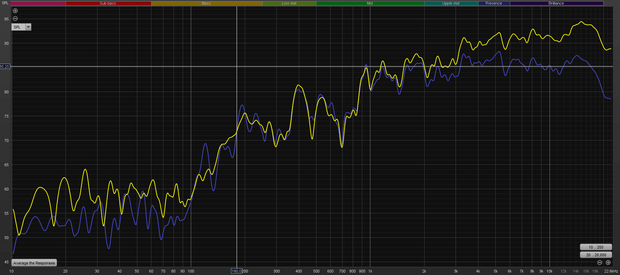Shannanigans
Registered
Thread Starter
- Joined
- Dec 1, 2021
- Posts
- 3
Hello, I recently built 2' wide floor to ceiling super chunk bass traps from OC703 and installed them in all 4 corners of my mixing room.
I took REW measurements following Soundman2020's instructions (John Sayers Forum) both before and after the installation and did not see any improvement. I'm using Kali LP6 monitors, a umc1820 interface, and EMM-6 measurement mic.
Do the readings in the attachment look realistic (blue is before treatment, yellow is after)? I'm surprised there is not a distinct frequency that the signal rolls off to 0 dB at. Additionally, while my room isn't ideal (small with 7' 7" high ceiling), I would think the bass traps should have had a more noticeable effect.
I took measurements earlier in the day (unfortunately they didn't save), after I put the treatment up, that looked more like I would have expected: A hard roll off starting at 40Hz with a steep dip in the bass range. The dip's trough would increase in frequency as I moved the monitors closer to the front wall. However, when I went to redo them, I got results like you see in the attachment even though nothing in my room or audio equipment changed.
Thank you in advance for your input.
I took REW measurements following Soundman2020's instructions (John Sayers Forum) both before and after the installation and did not see any improvement. I'm using Kali LP6 monitors, a umc1820 interface, and EMM-6 measurement mic.
Do the readings in the attachment look realistic (blue is before treatment, yellow is after)? I'm surprised there is not a distinct frequency that the signal rolls off to 0 dB at. Additionally, while my room isn't ideal (small with 7' 7" high ceiling), I would think the bass traps should have had a more noticeable effect.
I took measurements earlier in the day (unfortunately they didn't save), after I put the treatment up, that looked more like I would have expected: A hard roll off starting at 40Hz with a steep dip in the bass range. The dip's trough would increase in frequency as I moved the monitors closer to the front wall. However, when I went to redo them, I got results like you see in the attachment even though nothing in my room or audio equipment changed.
Thank you in advance for your input.














